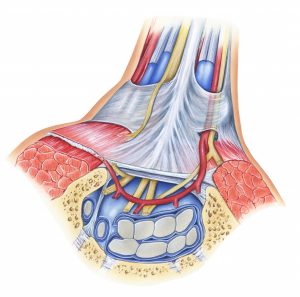
Treatment Options for Carpal Tunnel Syndrome
Leave a CommentCarpal tunnel is one of the most well-known and commonly treated hand/wrist conditions. Some of the telltale signs of this condition include numbness and/or tingling throughout your thumb, index finger and middle finger, as well as weakened grip strength and decreased hand coordination. Not everyone notices pain, although pain in the palm or wrist is not uncommon.
Carpal tunnel can occur for a variety of reasons; generally due to poor wrist positioning, repetitive gripping or flexing of the wrist, or prolonged vibration or impact through the hands/wrists. Read below to learn more about this condition and treatment options to help manage the pain.
The Anatomy of Carpal Tunnel Syndrome
 Carpal tunnel syndrome is caused when the median nerve, which provides sensation for your thumb, index finger, middle finger and half the ring finger, is compressed. The carpal tunnel is a small area at the base of the palm of your hand that contains the median nerve as well as nine tendons – therefore there is very little extra room. Compression can occur due to internal or external factors. Internal factors may include inflammation or a fracture, while external factors include prolonged or repetitive flexed positioning, repetitive gripping, prolonged vibration or impact through the wrists.
Carpal tunnel syndrome is caused when the median nerve, which provides sensation for your thumb, index finger, middle finger and half the ring finger, is compressed. The carpal tunnel is a small area at the base of the palm of your hand that contains the median nerve as well as nine tendons – therefore there is very little extra room. Compression can occur due to internal or external factors. Internal factors may include inflammation or a fracture, while external factors include prolonged or repetitive flexed positioning, repetitive gripping, prolonged vibration or impact through the wrists.
Treatment Options for Carpal Tunnel Syndrome
It is important to address carpal tunnel symptoms as soon as possible. Addressing carpal tunnel requires a combination of changing your habits, hand/wrist positioning, and bracing to rest the carpal tunnel area.
Bracing
Using an orthosis (brace) to hold your wrist in a neutral position decreases pressure on the median nerve by creating the most space possible in the carpal tunnel. Wear your brace at night to avoid sleeping with your wrist in a bent position. Orthoses can additionally be worn during the day for activities requiring repetitive wrist movements. Remember, orthoses should always be treated as a reminder and not a barrier to fight against!
Ergonomics
POSTURE! The median nerve is formed by nerve roots that combine near the shoulder, then travel down the arm to your hand. Therefore, slumped or slouched posture can increase pressure on the nerve at the beginning of its pathway. Two simple exercises can help to strengthen and retrain the muscles for good posture:
- Chin Tucks: Begin seated with good posture. Gently move your head backward without bending your neck back as if you are making a double chin. Hold briefly, then relax. Perform 20 repetitions, two or three times a day.


- Shoulder Blade Squeezes: Begin seated with good posture. Squeeze your shoulder blades together and down, as if you are tucking them in your back pockets. Hold briefly, then relax. Perform 20 repetitions, two or three times a day.


In addition to the above exercises, maintaining core strength and overall conditioning is essential for healthy posture.
Workstation Setup
Many of us spend at least 8 hours a day at work. Making some simple changes can decrease carpal tunnel symptoms. If you work at a computer, always ensure that your computer monitor is at eye level and that your keyboard and chair are arranged so that your shoulders are relaxed and your elbows are held at an approximately 90 degree angle. Lastly, ensure that your wrists are not bent forward or back. A wrist rest that allows your wrists to remain in neutral position while still moving freely is ideal. The same principles apply for any work at a workstation. For more detailed information, read our blog on the topic.
It is important to note that if symptoms do not improve after 3-6 weeks, it is recommended that you seek out further advice from a medical professional.
Working Safely
Many everyday hobbies such as gardening, sports or house cleaning can contribute to carpal tunnel syndrome. Luckily, simple modifications can allow you to continue your favorite hobbies without increasing symptoms. Wearing sturdy gloves that absorb vibrations and have a good grip helps reduce the force required throughout the wrist and hand. Tools with wider, contoured grips allow hands and wrists to remain in a more relaxed position during use. Also, make sure to avoid prolonged or repetitive heavy pinching and gripping – especially with a bent wrist.
If your carpal tunnel syndrome symptoms are having an impact on your daily life, schedule an appointment with one of our occupational therapists. Our experts will assess your condition and provide recommendations for treatment.
Appointments are available in-clinic and virtually through telehealth.
The Athletico blog is an educational resource written by Athletico employees. Athletico bloggers are licensed professionals who abide by the code of ethics outlined by their respective professional associations. The content published in blog posts represents the opinion of the individual author based on their expertise and experience. The content provided in this blog is for informational purposes only, does not constitute medical advice and should not be relied on for making personal health decisions.
Resources:
1. Cooper, C. (2014). Fundamentals of Hand Therapy: Clinical Reasoning and Treatment
Guidelines for Common Diagnoses of the Upper Extremity. St. Louis, MO: Elsevier Health
Sciences.
2. Hall, B., Lee, H. C., Fitzgerald, H., Byrne, B., Barton, A., & Lee, A. H. (2013). Investigating the
Effectiveness of Full-Time Wrist Splinting and Education in the Treatment of Carpal Tunnel
Syndrome: A Randomized Controlled Trial. American Journal of Occupational Therapy, 67(4),
448-459. doi:10.5014/ajot.2013.006031
3. Is My Computer Causing Neck Pain? (2017, January 19). Retrieved from
athletico.com/2013/02/11/is-my-computer-causing-neck-pain/
4. Novak, C. B., & Mackinnon, S. E. (1997). Repetitive use and static postures: A source of nerve
compression and pain. Journal of Hand Therapy, 10(2), 151-159. doi:10.1016/s0894-
1130(97)80069-5
